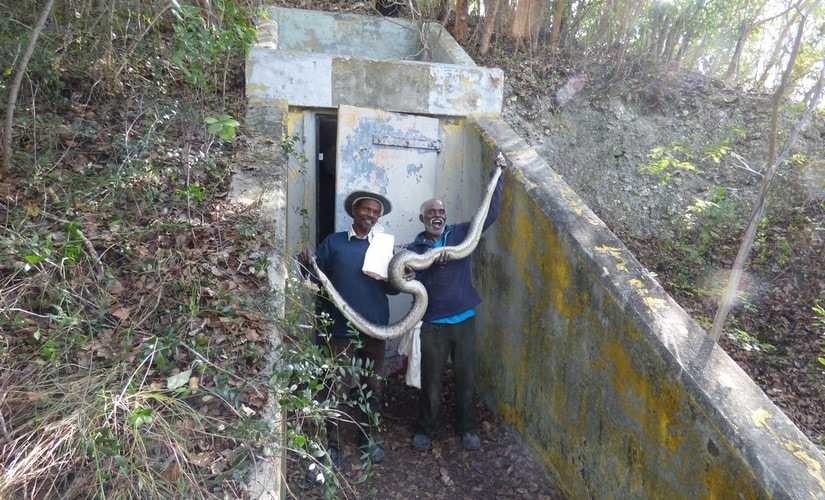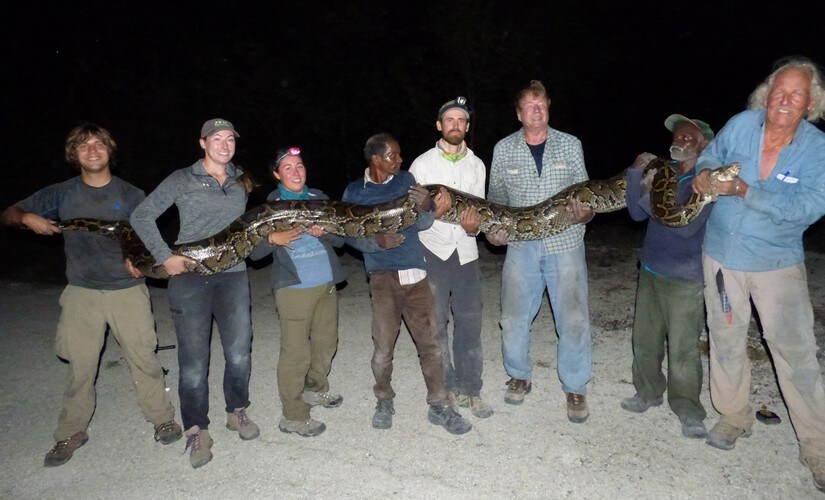The two Irula men leaped down the grassy slope and pulled out an eight-foot-long Burmese python. The snake was so big it couldn’t escape once seen. The snake struggled and emptied its bowels on Masi, who held the tail and didn’t avert its cloaca in time. The stinking creamy yellow waste smeared his clothes. After the Irular bagged the python, the grinning but impressed Americans held their noses with their fingers, miming how stinky the snake feces was. “I can’t be bothered with the shit,” Masi declared in Tamil. “Only if you are covered in it, can you catch snakes.” He pinched some with his fingers and applied it to his forehead theatrically. That was Masi and Vadivel’s second day in the Everglades, Florida, and they had caught their fifth python. Burmese pythons are one of the largest snakes in the world, reaching 20 feet in length. These natives of Indochina got loose in the vast wetland ecosystem of southern Florida, where the warm subtropical climate suited them fine. By the mid-1990s, they were all over Everglades National Park. Water and wildlife management workers discovered the first nest in 2006 within the park and caught nearly 600 until 2007. No one knows how many pythons live in Florida. [caption id=“attachment_3218402” align=“alignleft” width=“825”]  Masi and Vadivel with the first python they caught on Key Largo. Photo credit: Janaki Lenin[/caption] Although the snakes eat anything that walks or flies, they hit prime time news when they fight to the death with alligators or swallow three deer. Until 1999, raccoons, Virginia opossums, and marsh rabbits lying dead on the roads at night were a common sight. But after 2003, no rabbits counted among the road-kills. In 2012, scientists’ observations of raccoons and opossums that forage at the water’s edge decreased by 99 percent, white-tailed deer by 94 percent and bobcats by 87 percent. Circumstantial evidence painted the pythons as the culprits. In 2015, scientists conducted an experiment with marsh rabbits that further implicated the pythons in decimating mammal populations. Various wildlife management agencies struggled to contain the snakes. In 2009, as he read news of the initial snake developments in his homeland, my husband, Rom Whitaker, came up with an idea: bring Irula tribe snake hunters from Tamil Nadu to Florida. They had caught snakes including pythons for the skin industry until 1975, when India banned the trade. He had declared that the Irular were ‘world’s best snake hunters’ because they track snakes down into their burrows. Would they be as effective in unfamiliar terrain such as the Everglades? Few in wildlife management agencies in the US were convinced. Scientists tested various methods, including a beagle called Python Pete, heat sensing drones, traps, and local snake hunters, to track these reptiles. They surgically implanted radio transmitters in large female pythons and let them loose. These Judas snakes led them to other pythons. During the breeding season, male pythons seek females and often many males court the same female. All these methods brought limited results. In the meantime, Rom kept in touch with Professor Frank Mazzotti of the University of Florida and Joseph Wasilewski, a herpetologist-friend of many years. He also got passports and American visas for Masi and Vadivel with assistance from Icon Films, a film production company in the UK. But there was no positive news from the Americans. If the pythons weren’t contained, how far would they spread? In 2008, scientists estimated the pythons could invade a third of the United States, north to Washington DC and west to San Francisco Bay. Others refuted this prediction, saying the extreme winter cold would be a major obstacle to pythons. Indeed in January 2010, extreme cold killed several pythons in shallow marshes. Over 3000 have been removed until now. [caption id=“attachment_3218404” align=“alignleft” width=“825”]  The 15-foot female python caught on Key Largo. Photo credit: Janaki Lenin[/caption] In August 2016, the Florida Fish and Wildlife Conservation Commission green-lighted the project. One week after a python anointed Masi with its feces, Masi and Vadivel hit the jackpot. We were looking around the abandoned Nike missile base in Key Largo’s Crocodile Lake National Wildlife Refuge, while waiting for permissions to hunt in other areas of the Everglades. “It’s not a great place to catch pythons,” said Joe, preparing Masi and Vadivel for a fruitless day. But the Irula men spotted one deep inside an electrical channel in a concrete bunker. They lashed three saplings together to make a long pole and prodded the snake to come out. The adult female was eight feet long. As Masi and Vadivel continued to hunt, they were oblivious to the rising excitement among our American friends. “No one has gone looking for pythons in Key Largo and found them,” said Ed Metzger III, the biologist attached to the project. On the mainland, Ed had caught an eighteen-footer almost single-handedly in 2015. He had no bag big enough to hold the snake, so he crammed it into a large plastic storage container. Ever since they heard his tale, Masi and Vadivel were determined to find a snake just as large. With a machete, Masi cut the strangler fig roots that blocked the entrance to another bunker. Nobody had been inside in a long time. Vadivel and he pried the creaky old door open and disappeared inside. The rest of us chatted outside. The chances of finding another python were zero, others said. Along the way to the bunker, we had passed drift fences, long stretches of plastic sheets propped upright. Every day interns from the US Geological Survey checked traps of various kinds set along these fences. In 2007, a researcher studying the endangered Key Largo woodrat found one of her radio-collared animals inside a python. That was the first python to be caught on the island. Since then, the snakes were found dead on the highway or caught crossing a levee like the law enforcement officer caught in August last year. That was also the time when hatchlings were seen on the island but only one was caught. The species was breeding on the island. But the traps laid all around the park caught no pythons, and neither did the interns find any. “Malappambu,” called a giggling Masi from inside the dark bunker. Python. Was he teasing us? We scrambled inside the bunker and peered into the shaft with a powerful torch. An enormous coil of a python filled the 18 inch by 9 inch tunnel. One of the interns fetched the long pole from the other bunker and Masi poked the snake. Vadivel went around the back of the berm and started digging into the limestone substrate with his crowbar. The strategy was to irritate it enough to make it move. But it wouldn’t budge. Rom and Joe took over the job of prodding while Masi helped Vadivel dig. I coordinated the two teams, translating from Tamil to English and vice versa. The Irula men broke through the concrete shaft and hauled out the python. While we clicked photographs, someone mentioned the male snake wasn’t as big as it seemed in the tunnel. Was there another python? We raced back into the bunker and peered inside. Yes, the big python was still there. Everyone went back to work. As the minutes wore on, Joe went around the back and hauled the snake through that opening. It was another male but it wasn’t the big snake. Finally, after dark, they grabbed the snake’s tail and it took six people to pull the female out. She was going into a shed. Since this was the beginning of the breeding season, the two males had holed up with her. Since his encounter with the large python, Ed had a custom-made bag for such large mammas. It weighed 75 kilograms and measured 15.65 feet. One such snake can swallow at least 10 woodrats in one sitting. Matters could be worse for the Key Largo woodrat and another endangered rodent, the cotton mouse, than everyone thought. So far the Indian snake hunters have caught 14 pythons in 14 days. The latest to join the fight to save Florida’s native fauna is the python’s old adversary from the old country – the Irulas.
Burmese pythons are one of the largest snakes in the world, reaching 20 feet in length. These natives of Indochina got loose in the vast wetland ecosystem of southern Florida, where the warm subtropical climate suited them fine
Advertisement
End of Article


)
)
)
)
)
)
)
)
)



